Musings

I haven’t mentioned wild critters so far. On day one we saw a beaver crossing the road. Pretty sure on that ID, and definitely on the location. Strange. On day two, we spotted antelopes. Not many, but they were out there in the windswept terrain. Today, we just moseyed along pretty early, and whoops, look in with those cattle…odd shapes…yup, two bison. I don’t think we will do better tomorrow and the coming days…unless…elk?
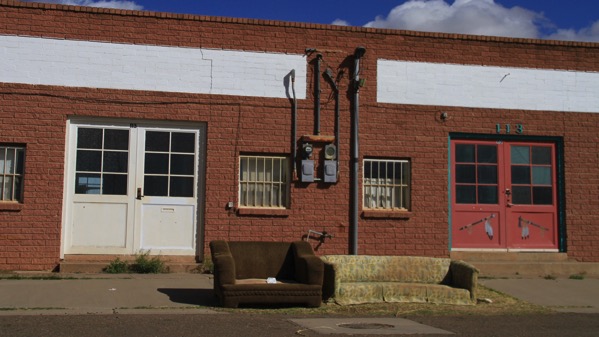
Off in a nearly abandoned part of town, we found this pair of couches perhaps commiserating on the lousy neighborhood…or waiting for a parade?

For lunch we found a real Mexican place. I had a red and a green tamale. With a side of beans. I was stuffed. The two sauces provided were both cooked, so a real contrast to yesterday’s salsa offerings.
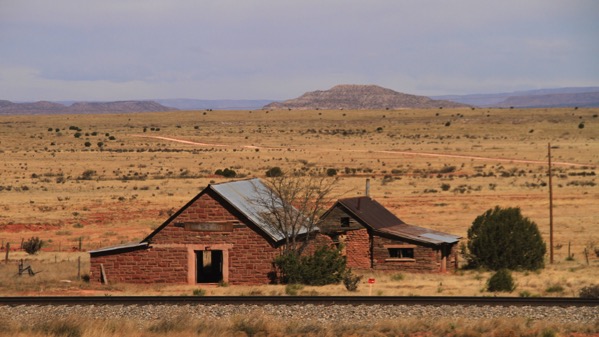
The Guru made this shot, a real grab of an abandoned ranch with a butte not far distant (I was driving; foot’s doing quite well, thank you). The sign says “Baptist Church.” Life after ranch.

That line of mountains in the distance, that’s the east side of the Sandia Mountains, which are the east side of the Albuquerque basin. There’s a road to the top, very winding and slow; it passes a ski area and a parking lot signed winter play area. We took that road. It hammered our mileage even worse than the winds and gentle upgrade have over the last two days.
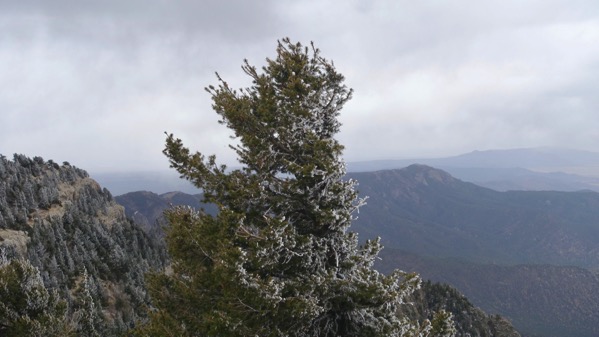
The vegetation at the top was rimed in a snow-ice combo. The wind was fierce. We made a quick walking loop, clicked a few frames, and scuttled back to the quiet of the car. And warmth; the car indicated it was 22°F outside. [Remember, we were in 104 yesterday.]
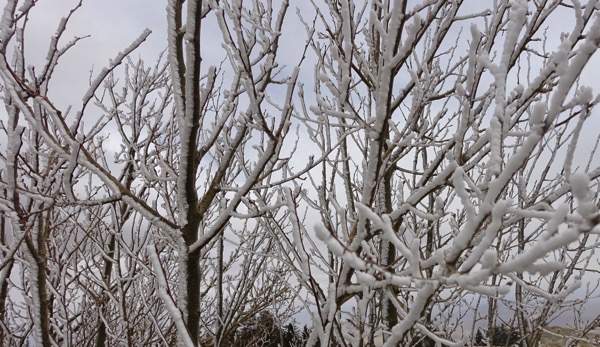
The rime was pretty thick, and one sided. The wind was strong enough to blow pieces off and we could see small white bombs scattered on the blacktop.
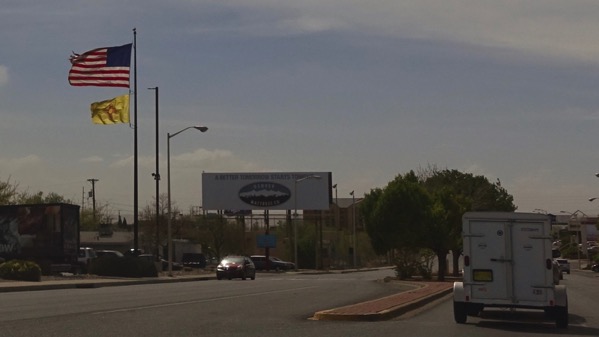
We headed down, garnering all the battery-energy we could. The battery level went from below zero (zero on the gauge not being empty but false empty that keeps a bit of charge in the battery at all times), to 59%. Now, that’s a downhill!
And in ABQ: yup, still windy. Supposed to slack off in the evening. Can’t wait!
Posted at 9:41 PM |
2 Comments »
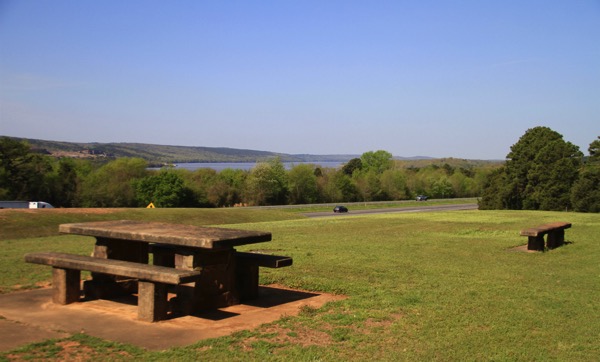
Most of today’s photos were through a bug-marred windshield or a reflection-blotched side window. We walked up to this overlook with a good view of the Arkansas River—which must have been great when the trees were younger, but now they hold more carbon.
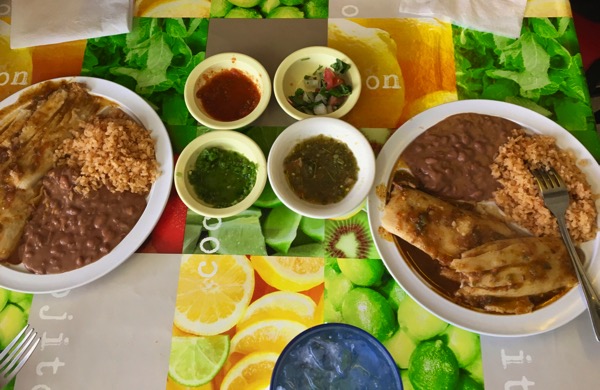
We got away from the interstate and went to a tamale place. The menu was on a sign, but didn’t include tamales. Uh oh. But we asked, and indeed got two plates of pork/red sauce tamales. Apparently the local preference is for the homemade hot sauce on top, so we had that, too. The other four salsas were offered in a salsa bar. The salsas were stupendous. The owner is from Michoacán—so the food is not TexMex as it is most places—we were told.
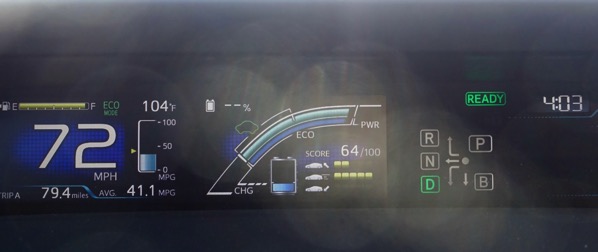
We kept grinding westward. Hot outside; strong AC inside. Look at this: 104° at 4:03pm in western Oklahoma. Yikes. That was the high. There’s a weather system passing through…um, tomorrow?…and temps will drop. This might have been a record-high. It was also super-windy. The big commercial flags were totally horizontal; we heard gusts were expected to be up to 50mph.

Not surprisingly, after we left the trees behind, we saw lots of wind plants…whole forests or plantations of them. We agreed that we were seeing more than a couple of years back.

We did encounter this one blade traveling down the highway. We wondered if it was defective. Perhaps a half-hour later, we saw two other blades on trucks that had pulled off the interstate. We figured that somehow the two parties and three blades had gotten separated. [We make up stories all the time to fit what we notice as we go down the road.]
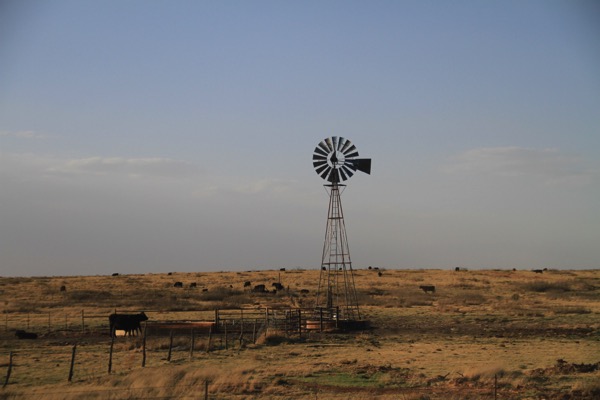
Seems like the windmills—the old-fashioned kind like this—are fewer and fewer. Stands to reason. And they are difficult to photo at highway speeds!
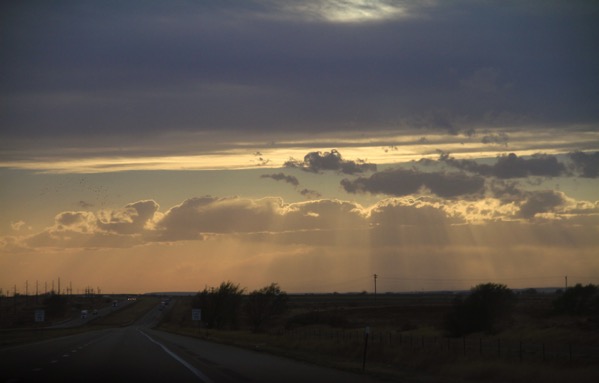
And oh my was the sky pretty as we traversed the final miles of the day. The camera makes it darker and more contrasty than it was. Still: nice god-rays, looking even better against the empty, distant skyline.
Posted at 10:52 PM |
Comments Off on Snapshots

You can’t tell all the taste-layers in the stratigraphy of this grand burger. There are two straight-forward patties, each with a melted processed cheese square, onions fried in the burger-grease, some BBQ, fried bacon, small scoop of slaw, tomato slices, lettuce, soft toasted bun, mayo, ketchup, and mustard. That’s what I saw, anyway. It’s a Ghetto Burger from Ann’s Snack Bar. And it was lauded in a recent episode of “Billions.”
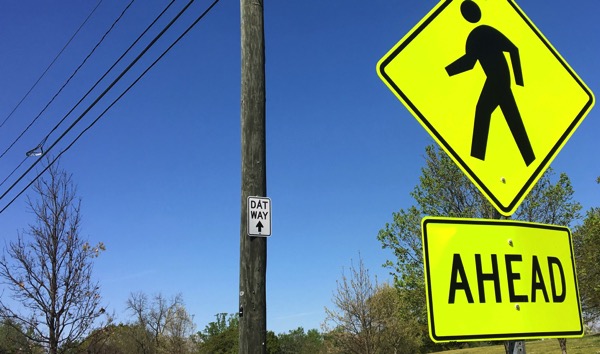
The Guru spotted this on Instagram, and we saw it for real. I don’t know if the signs are intended to be read in conjunction or independently.
So, the first photo is indigenous cuisine, and the second is indigenous signage.
Posted at 7:06 PM |
Comments Off on Indigenous…

Lazy me, I took yesterday’s chili and…goosed it. Added quick-sauteed veggies atop, with a sprinkle of finely sliced onions.
Not stupendous, but worked for us.
Posted at 9:02 PM |
Comments Off on Leftovers by another name
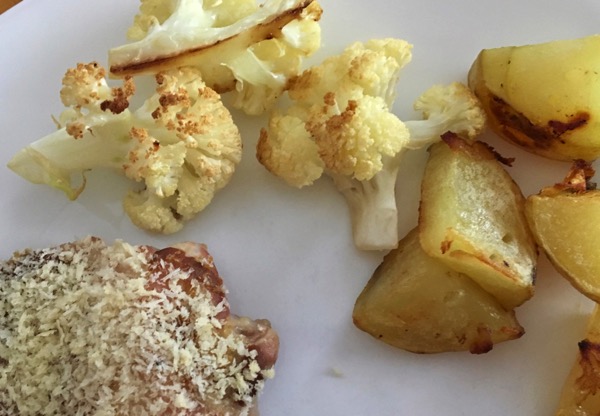
We had a blonde dinner. Before roasting, it was exceedingly beige. Know that we had big green salad with sliced tomatoes, too—so color there.
Posted at 9:29 PM |
Comments Off on Unfiltered (menu)

My first mystery: what is this flower called? I don’t ever remember an ID on it…. Kinda like a stalk of violets…which seems impossible.
My other mystery: pemmican. I read about a buffalo jump (stone walls for driving bison to a cliff, where they’d fall and be butchered) near Cut Bank, Montana…which we remember for the giant penguin statue (yeah, Goo it!). The archaeologists concluded that the folks processed the carcasses for several special items, including bone grease. For pemmican.
Just how many paleo-diet freaks today make bone grease? An almost lost art?
The pemmican brings up one of those repeating topics I think about…how folks preserve food so it doesn’t spoil and yet remains tasty (or a version of tasty). A culture’s food specialties are in two categories that smear together. One is the food served on a given day. The other is the way fresh foods are preserved, for example: wine, cheese, dried meat, pickled eggs, sauerkraut/kimchee, salted fish/meat, soy sauce…that kind of thing. Cannot require canning (for example) to preserve…. The cuisine then can use both preserved foods and fresh foods together….
Anyway.
Posted at 9:37 PM |
2 Comments »
I’m offering two photos of each city we visited….
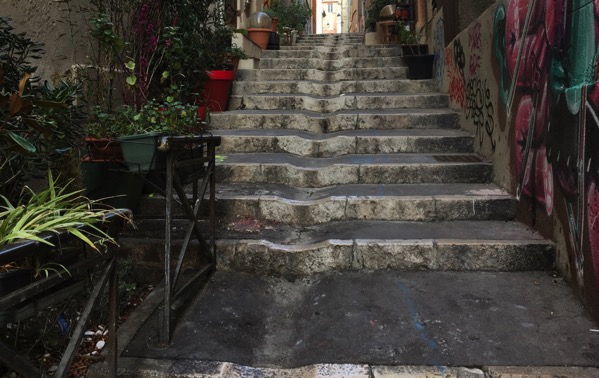
We might even call this Memory Lane, Marseille.
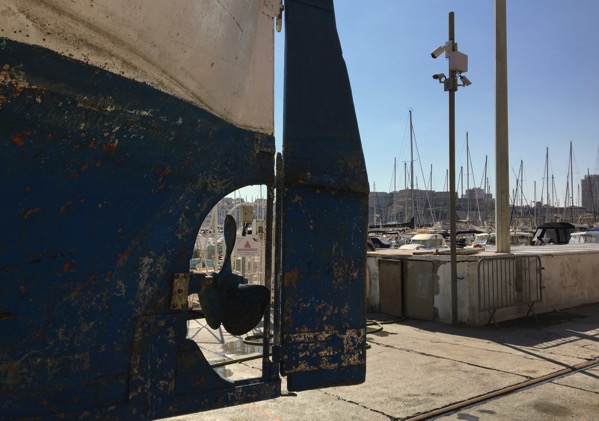
Rudder view, dry dock boat, old harbor.
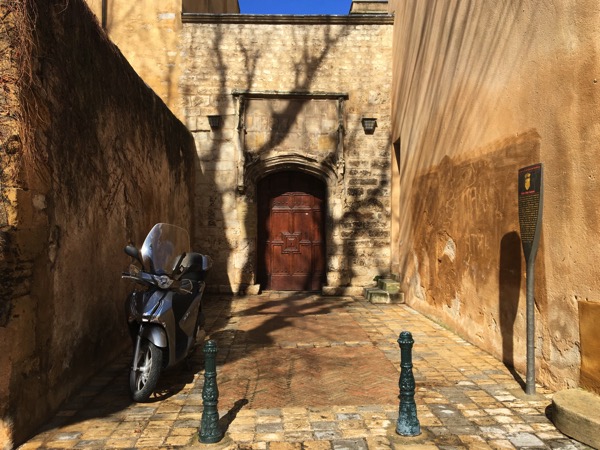
On to Aix…love the shadows on the wall to the right, especially in contrast to those angled ones on the door wall.
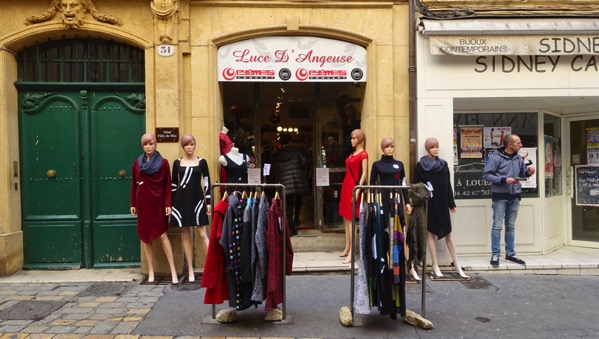
The shop attendees do step out onto the street when no one’s inside…but not to hail passersby, usually, instead to smoke. Love the rocks holding the racks and the shoeless manikins.
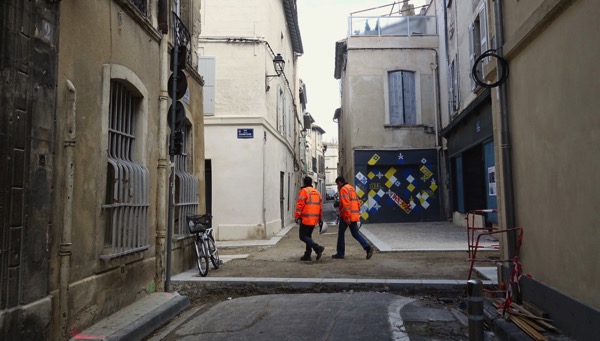
And in Avignon…narrow streets, some construction, often high crowns (suggests rain can gush here).
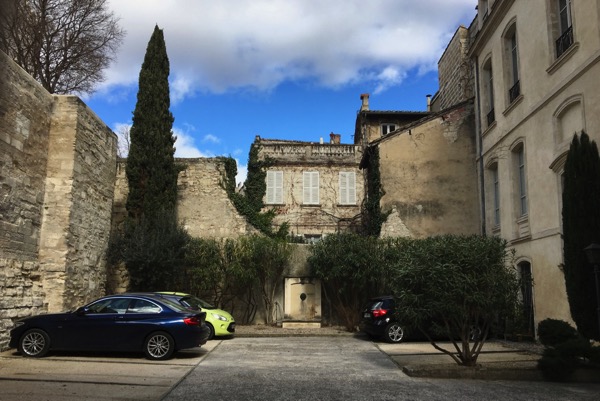
And sometimes a courtyard peek…usually no longer gardens, but turned into parking. The fountain at the back was preserved…and appears lonely with only a few companion woody plants.
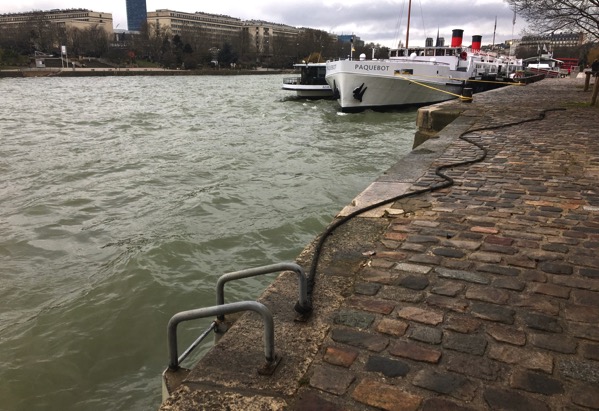
Paris…Paris is always Seine-side to me.
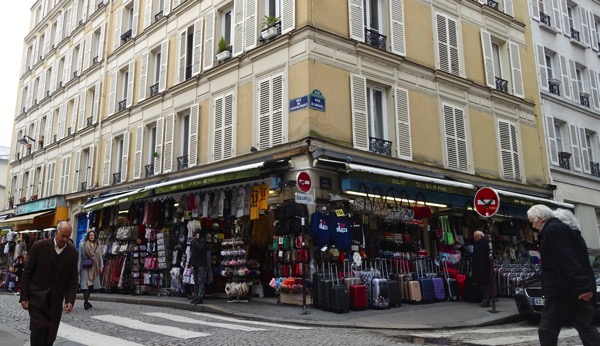
A shopkeeper believes this assortment will entice the many tourists streaming by headed to Montmartre. Why all the hard-sided luggage? Do the vendors push some cheap knockoffs? Who buys a suitcase to trundle around while sight-seeing? Someone must…makes no sense to me. Postcards and miniature Eiffel Towers, yes, but carry-on roller bags?
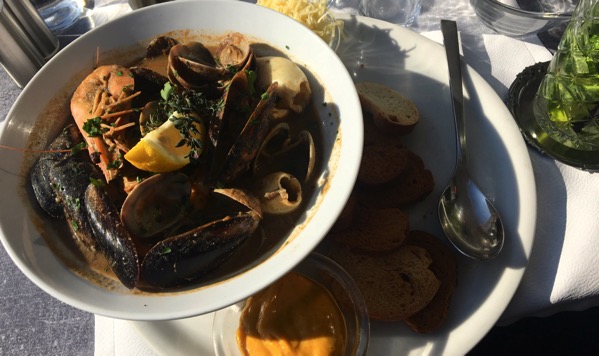
Okay, one food picture just like during the trip. This is the marmite (say mahr-meet), or seafood stew, that I had in Marseille. Served with dry bread to soak up the juices. And, here, also with grated hard cheese and sweetened mustard. I didn’t know about this stew before the trip, and now I do.
This is one reason to travel—learning something that becomes a reason to return. I had thought I would find Marseille gritty and off-putting. Perhaps before the harbor was turned into a tourist haven, when it was still fisherman and mariners, with smells of oil and fish and dirty sea-water, I would have struggled to find the charming. No longer. Am I a pushover?
Posted at 10:22 PM |
Comments Off on Memories
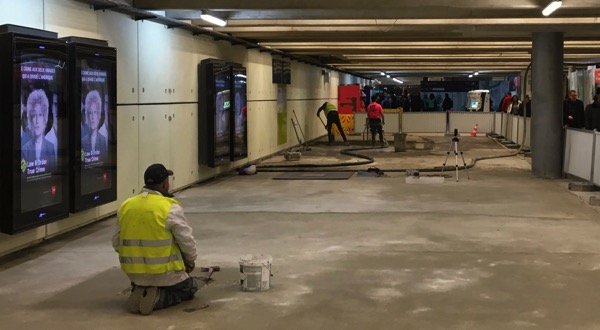
Today’s moving day.
We packed up and took the train to the Gare du Nord, and found workmen busy pouring concrete (rear). We left our luggage in a locker, and took off for a half-day of sight-seeing.

We found balloonists eyeing the Basilique du Sacré Cœur de Montmartre. Is that what gave us the inspiration to ascend on foot?
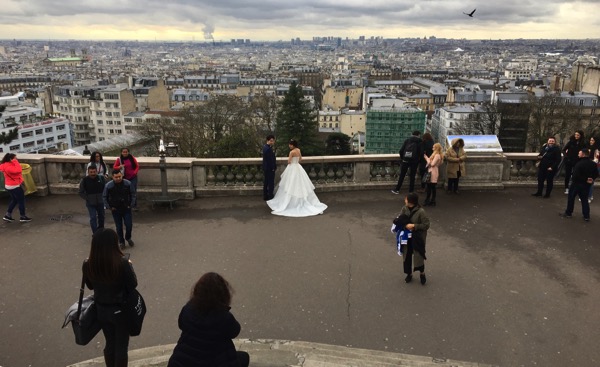
Most of the way up, we found our bride of the day. We saw the couple giggle together while the photographer was barking commands…seemed like a good omen for them.
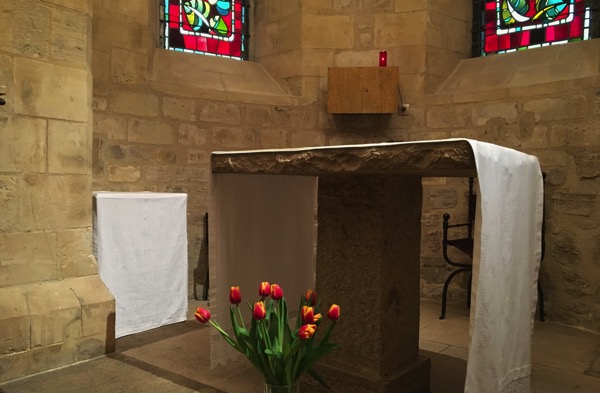
We walked around to the far less visited l’église Saint-Pierre, consecrated over 870 years (or, 87 decades) ago in 1147.
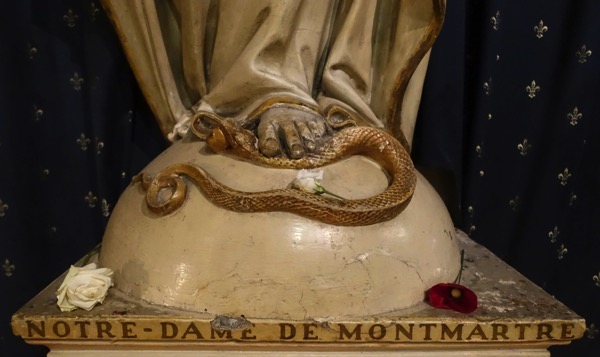
This church is where, among other things, folks honor Notre-Dame de Montmartre. She likes her snakes, I’m thinking, especially with fresh flowers.
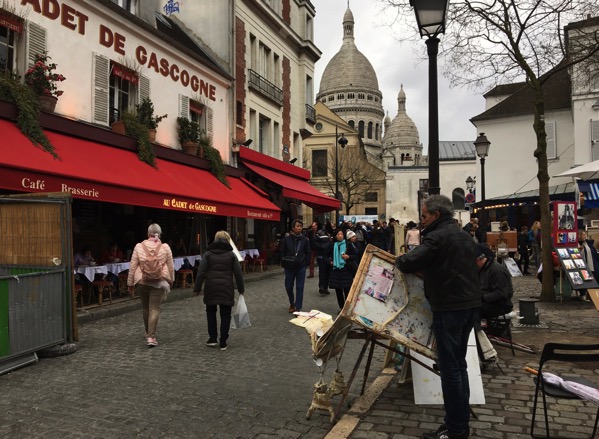
We toured through Place du Tertre, and watched arriving artists setting up, aware, I guess, of coming sunshine/good weather.
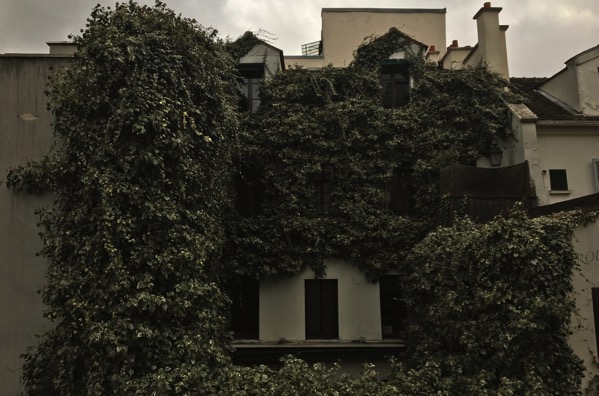
Working our way down, we had a couple of vegetation moments. I’d rent this place!
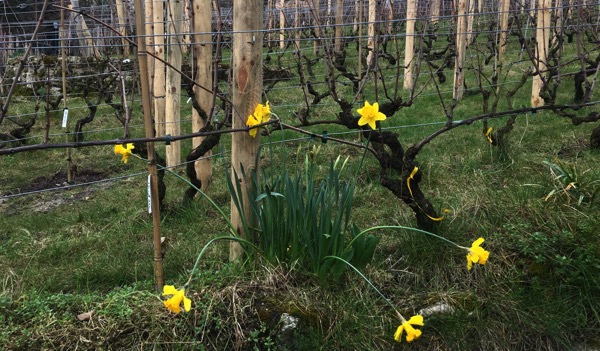
I vaguely knew there was a vineyard on Montmartre, but didn’t anticipate seeing it. Yay! With bonus daffodils!
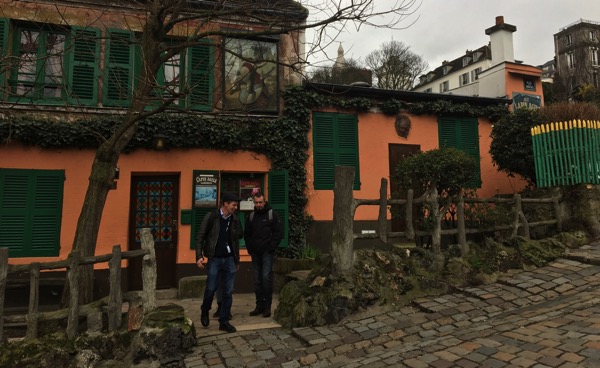
The Lapin Agile has many reasons for being a phrase rattling in your brain (e.g., Montmartre painters, Steve Martin play…)…and a much longer WikiPee page in French than in English.

Continuing our descent, we stopped for a bite at an old-timey (sorta) bistro. This was my shiitake soup with fresh Malabar pepper and chopped chives. I would never make it with this much pepper, but it was nuanced in flavor—and…interesting (why we eat at restaurants, no?).
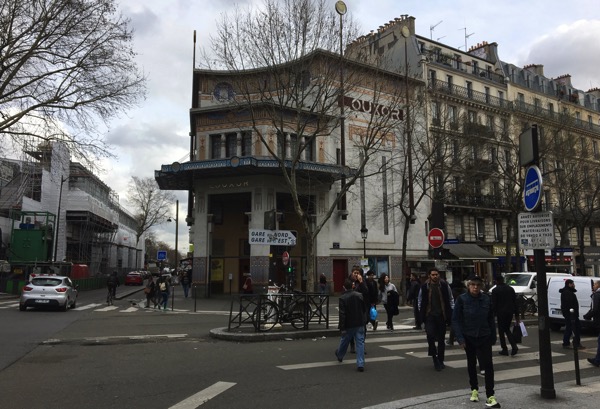
Our return route to the Gare du Nord passed opposite the Louxor, Luxor in English—because we don’t have the same linguistic need for extra letters? Interesting architectural details, yet oddly streamlined.
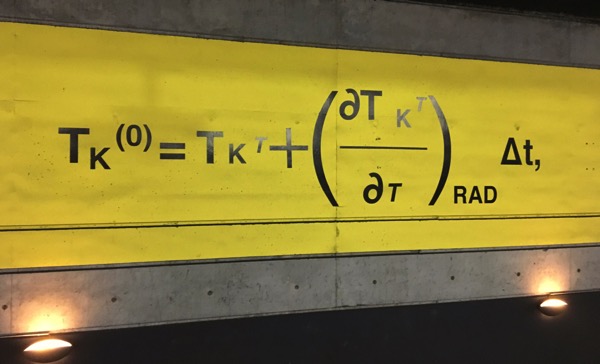
Found a series of equations on the walls of the station section (below where we arrived) where we waited for our airport train. I think this one is something about tickets, but am too brain-dead to figure it out.
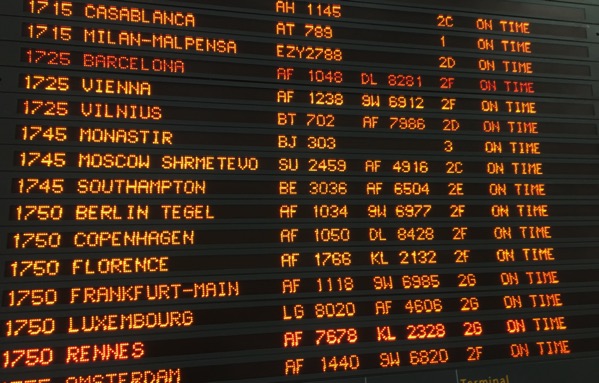
Flights listed at CGD Terminal 2. There‘s a real assortment of destinations!
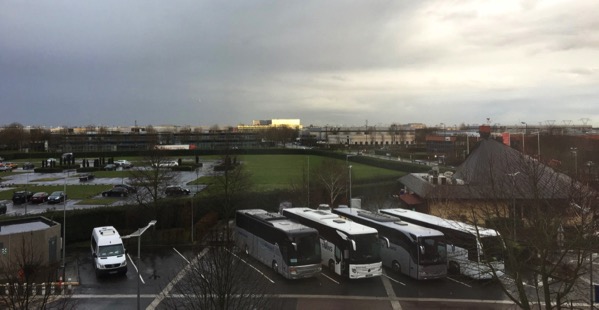
And as the sun was setting, we saw this brilliant reflection from our window…. We have an early call tomorrow to make our shuttle back to the airport…so, nighty-night.
Posted at 2:25 PM |
Comments Off on Metro visits, more

We took the Metro underground and made a connection to an above-ground tram, which meant we had a view! We rode oh-so-quietly along the Seine downstream, picked a station to hop off, and headed toward the Bois de Boulogne—a huge park that once was a hunting preserve outside the city, much like Windsor was to London. In 1783, this was where the first Montgolfier hot-air balloon was flown untethered. In 1814, after Napoleon’s defeat, abdication, and exile to Alba, 40K British and American troops camped here, cutting down trees and otherwise intensively occupying the landscape, leaving it quite ravaged. The park was created in the 1850s. The builders installed an extensive irrigation system with pipes going everywhere. Crews planted lawns, meadows, and 420K trees (says Wikipee).

We encountered this sign above a restaurant not far from the trolley station. I thought that’s not the kind of place I want to eat…rather have the not-bones part of the fish….
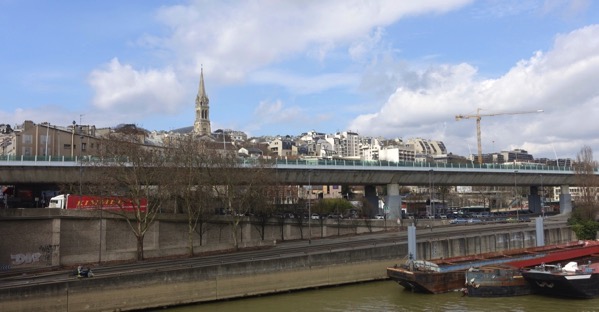
We crossed the Seine safely on a vehicle-busy bridge, then continued downstream.
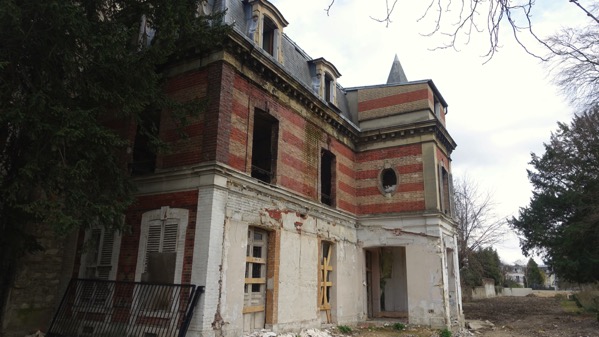
We passed this building undergoing rehab, slowly. Interesting architectural details.
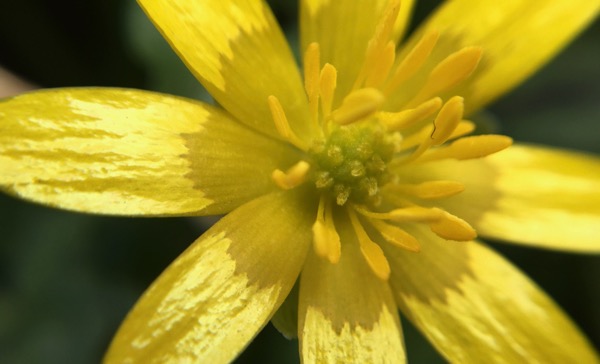
Here, outside the paving stones and micro-mananged enviroment on the old city, I found wildflowers! Fleur jaune.
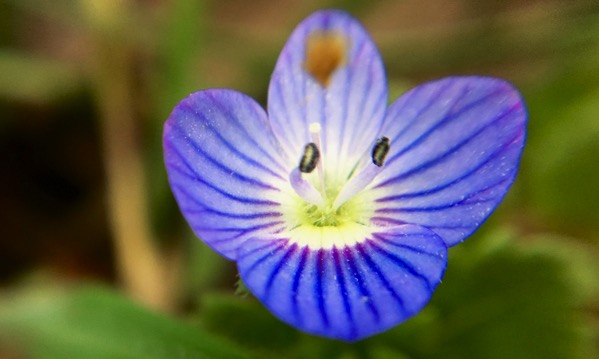
Tiny fleur bleu.
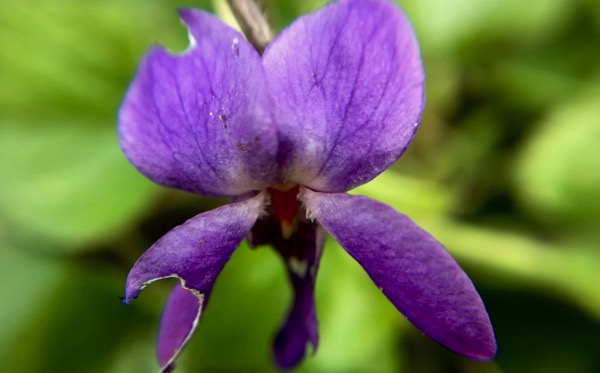
Fleur mauve.

We left the Bois and passed over this almost-moat and into a garden—jardin.

The main part was a large central conservatory (the palm house, natch), and six flanking arch-topped greenhouses in two trios.

Fleurs rouge.

Fleurs blancs.
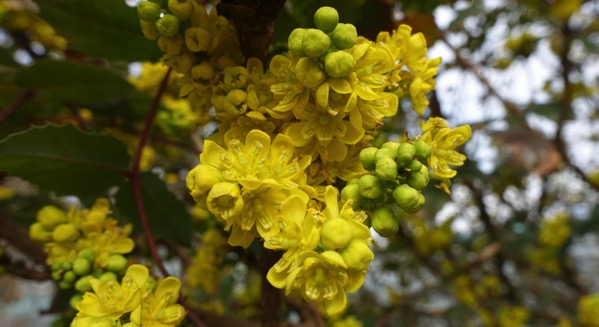
Fleurs jaunes.

Then, we turned back toward the apartment. First, we passed through a poets’ corner…this is Jean Moréas (1856–1910), who was born to an Athens family and originally named Ioannis A. Papadiamantopoulos. He came to Paris to study law. I think of him as Mr. Moustache.
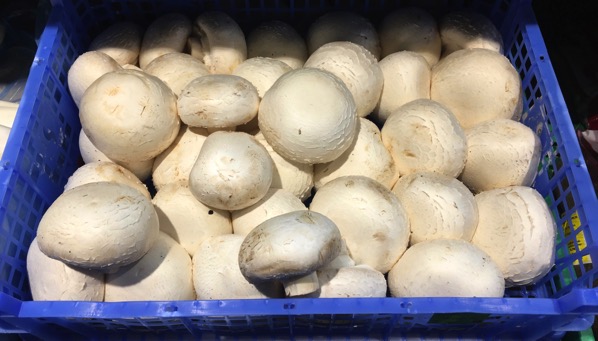
Back in our neighborhood, we made a quick store stop (milk for coffee!), and I found this carefully packed box of white button mushrooms (champignons de Paris), stunningly aesthetic and appealing.
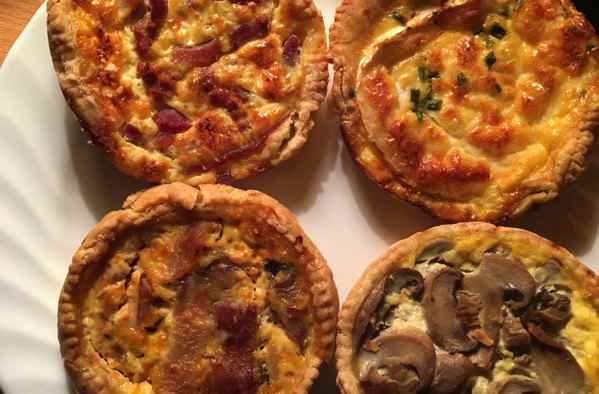
Okay, food pick—tonight’s quiche foursome. Plus salad.
Posted at 3:31 PM |
Comments Off on Flower day
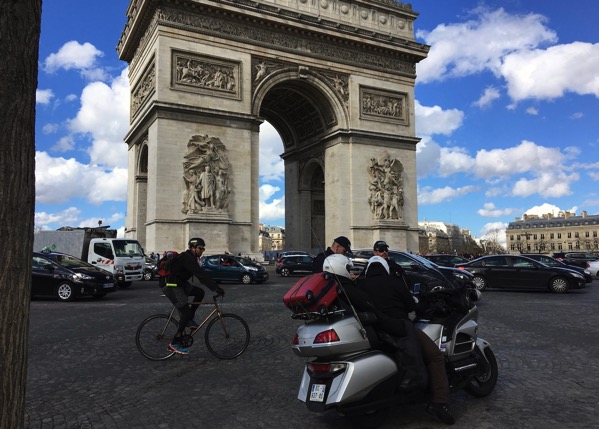
Our first stop of the day (other than the shower haha)…. This is a massive structure. It dwarfs the arches we saw in/by the Roman forum. Cops are earning their salary today…?!
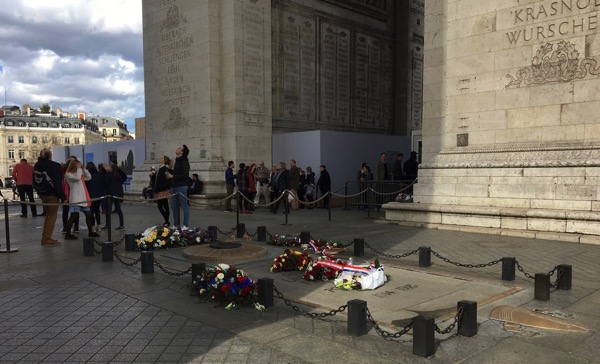
Beneath the arch is a perpetual flame honoring war dead (WWI). There’s a large brass plaque set in the pavement with the dates for each war. Oddly moving, even with the crowds burbling by, mostly inattentive to the flame, instead focused on where to line up to ascend to the top of the monument (€12; it’s free to do what we did, although it isn’t clear that you don’t have to pay the big €€€€ merely to walk around).
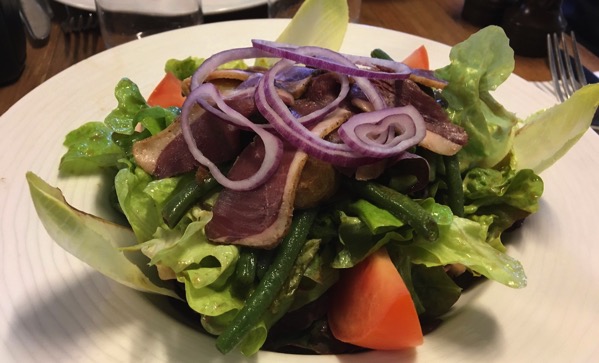
Stopped for lunch at a bistro most of the way down the Champs-Élysées, and it is downhill toward the river…. I had the salade de magret de canard, with green beans, onions, tomato slices, and roasted potatoes. Tasty but not exceptional…what I hoped for.
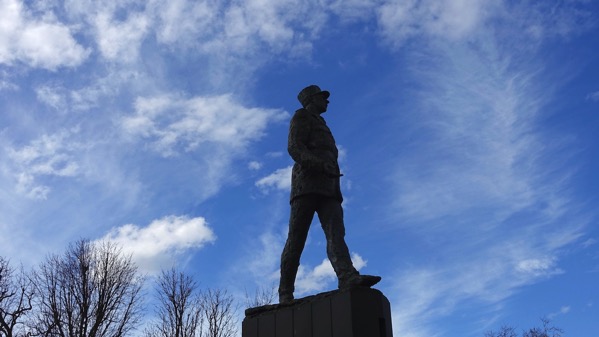
Didn’t expect this statue of Général Charles De Gaulle. A general-sculpture with no horse.
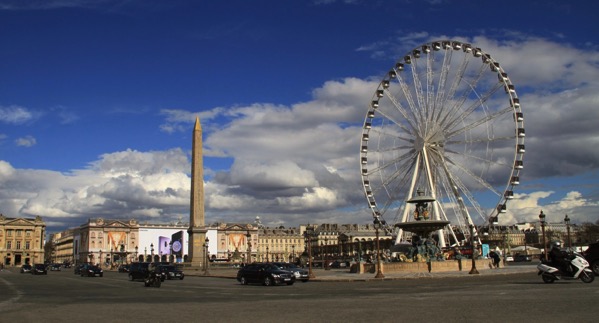
We’d been seeing this wheel since the Triomphe. It’s next to the huge oval traffic “circle,” at the Place de la Concorde. During the Revolution, many royals/nobles were executed here, when it was surrounded by an octagonal moat. The dead included Queen Marie Antoinette and Madame Du Barry, and over a thousand more.

A few more steps, and we entered the Jardin des Tuileries. I love that the park has many unmoored chairs, which people move around to suit themselves. Look at the crowds!
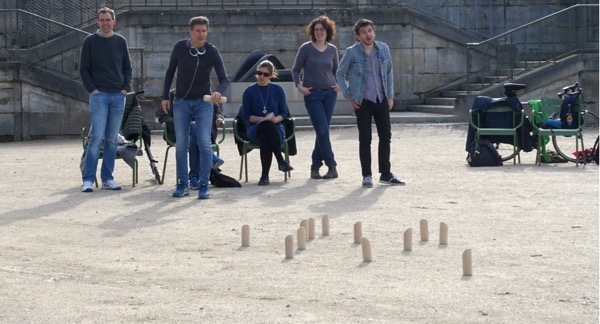
We found three sets of people playing this game. We didn’t watch terribly long, but it seems that the player throws the baton in such a way that it knocks down one of the pegs and tosses it forward. The player then walks out and stands up the peg in its new, more distant location. In our short period of voyeurism, we could not tell anything else about the game and its strategy.
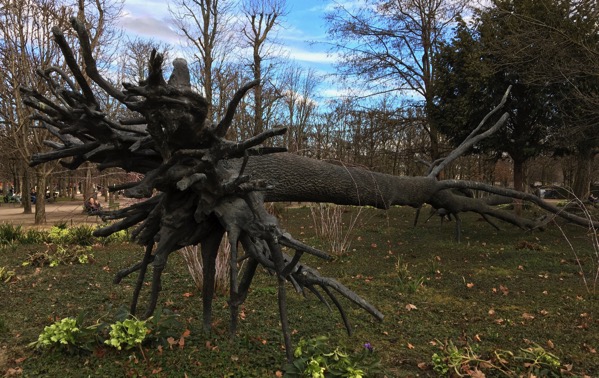
This is a dead-tree statue by Giuseppe Penone (b. 1947), and is called “L’Arbres des Voyelles” (1999), or the tree of the vowels. Apparently, the “vowels” are five oak trees planted among the upper branches. Can you see a delicate bunch of purple crocuses off the right-most root?

We saw another arch as we approached the Louvre. This one has fancier decorative elements (more gilding) than the Triomphe, and is much smaller. Can you see the glass pyramid through the right arch?
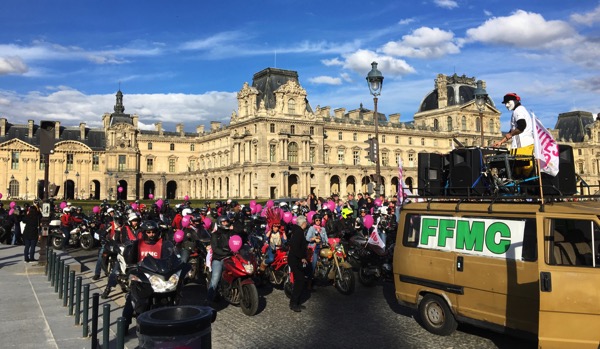
Our bus stop was off to the right. We got into position to wait for a bus, and started watching the oncoming traffic. Most of the buses were for sight-seeing, often with an open upper seating level. Then, we heard motorcycle cops with sirens whooping…several of them…wha? Quickly, we realized that they were the vanguard of a procession.
We were witness to the Toutes en Moto parade—mostly (all?) women on motorcycles and scooters. The lead van stopped right in front of us, and the DJ played a song, then two women ascended and one made a speech. Rousing, I thought, even though I only caught a few nouns…. Then, the riders put out their cigs, put away their selfie-phones, and climbed back on their two-wheelers. Rrrrr-rrrr, and away they went.
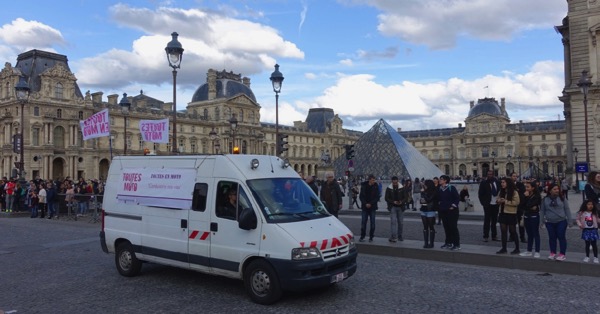
This was the final vehicle, and traffic began flowing again. And we noticed that no buses would be stopping at our stop…due to the parade, we assume, so we walked on across the river to where we assumed the detoured route would be.

Found the bus! Saving the feet!
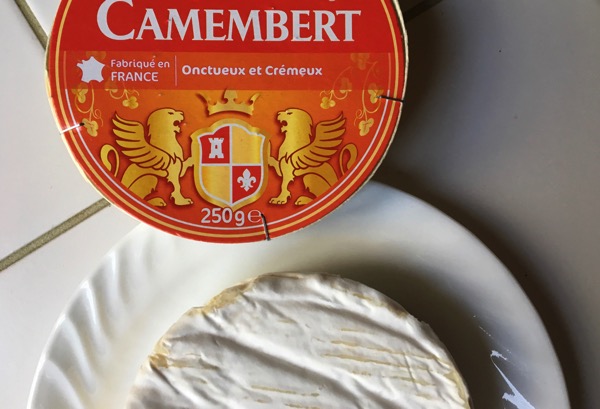
A quick stop at the bakery at the south end of our street (there’s one at each end! Lucky us!), and we ascended to the apartment…and a Camembert snack! Yum.
And wine! Salud!
Posted at 2:41 PM |
Comments Off on Tourism with Sunday crowds






































































